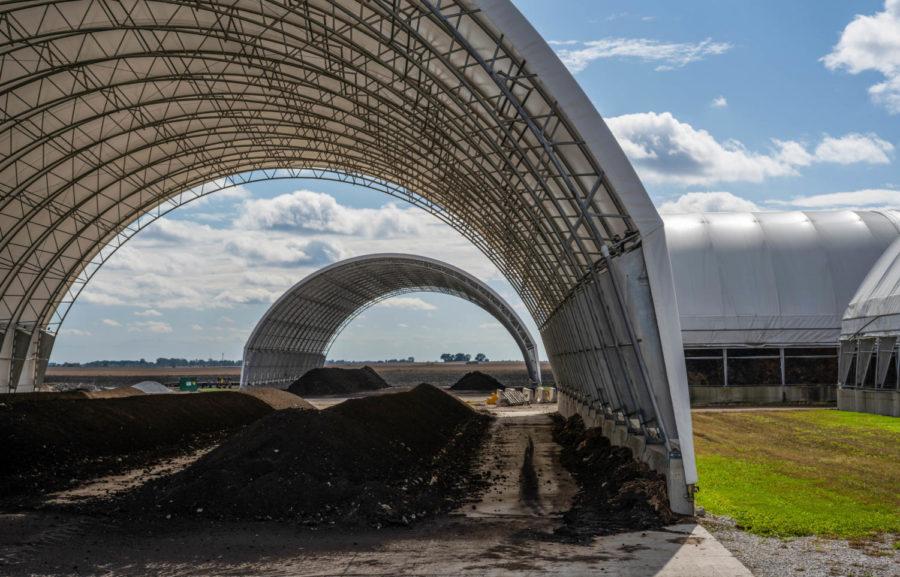Composting on campus demonstrates sustainability
Claire Corbin/ Iowa State Daily
The University Compost Facility, just four miles south of campus, is made up of various hoop barns covering piles of compost.
October 14, 2019
When people visit Iowa State, they might notice the many trees that line the sidewalks and cover central campus. In the fall, all the trees begin the process of losing their leaves. What most people don’t know is where all of the leaves go.
The collection of the leaves is a process most students aren’t aware takes place, but the process does not stop there. Iowa State takes fallen leaves as well as other materials and turns them into compost.
Just four miles south of campus is the University Compost Facility. At the composting facility, large piles of compost are stored under hoop barns and maintained by Steve Jonas, agricultural specialist in the Iowa State research farms department.
Jonas is the manager of the University Compost Facility and is in charge of making compost out of all the resources collected from campus.
Compost is made of decaying organic material and can be used as a plant fertilizer.
“It’s the taking of organic material — lawn clippings and animal waste, yard waste, food waste, that kind of stuff — and allowing the microbes that exist naturally to break it down into the organic matter of soil component,” Jonas said.
When making compost, a variety of materials can be used. The compost Jonas makes is mostly made up of organic material collected directly from Iowa State.
“Manure from the horse barns, food waste from all the dining centers, leaves from campus in the fall, grass clippings, greenhouse waste […] animal science will bring maybe old feed or something like that,” Jonas said.
Barbara Steiner, supervisor of plant services in the facilities planning and management department, oversees the campus employees part of the planting crew, which includes tree-trimmers, arborists, pest control and more.
Steiner said leaves account for a lot of the material collected on campus and used for compost, especially this time of year. In addition to leaves, the material from the greenhouses are also used.
Merry Rankin, program manager in the facilities planning and management department, is in charge of sustainability on Iowa State’s campus.
“All the pre-consumer food waste goes to the composting facility,” Rankin said. “Then all post-consumer food waste in all the residential dining facilities […] goes to the compost facility.”
The pre-consumer waste accounts for what is used in dining centers or before catering events. Post-consumer food is what people throw away after they are finished eating.
With all of this miscellaneous material gathered, Jonas can begin the composting process.
“I get it into piles — they’ll stay there for about four months,” Jonas said. “I’ll turn the piles periodically to add oxygen to the windrows to help the microbes do their job. And then I try to look for the right porosity, the right moisture content, the right carbon nitrogen ratio. When I get all of those in the right mixture, the microbes just automatically start doing their thing.”
Microbes are microorganisms that exist everywhere. These microorganisms break down the material to produce water, heat and carbon dioxide. When microbes do their job successfully, it results in soil better suited for plant growth.
Once the microbes break down the organic material, it can be put back onto the ground to benefit plant growth and health.
‘When it’s done, [I] mix it with top soil and make amended soil and that’s what goes back to campus around new construction, landscaping, all that kind of stuff,” Jonas said.
The compost can be mixed in different ways to accommodate different projects and needs.
“We have various mixtures, some for turf and some for Reiman Gardens,” Steiner said. “[Jonas] takes care of the mixing. We’ve worked with him over the years to get the mixes we like.”
If the collection of leaves and other materials did not take place, students may start to take notice, due to the lack of upkeep around campus and other direct results that derive from the collection of compost materials.
“Eventually, there would be spots where grass would get killed because they’d set in a big pile and no light or water would get to the grass and it would die,” Steiner said.
In addition to potential dead grass on campus, Steiner added humor to the fact that an excess of leaves could encourage students to make reckless decisions.
“There’d be more injuries to students because they’d rake them up into big piles and jump into them and break their arms,” Steiner said.
Iowa State not only contributes its resources to the making of compost, but also benefits from the many ways it is incorporated back on campus.







